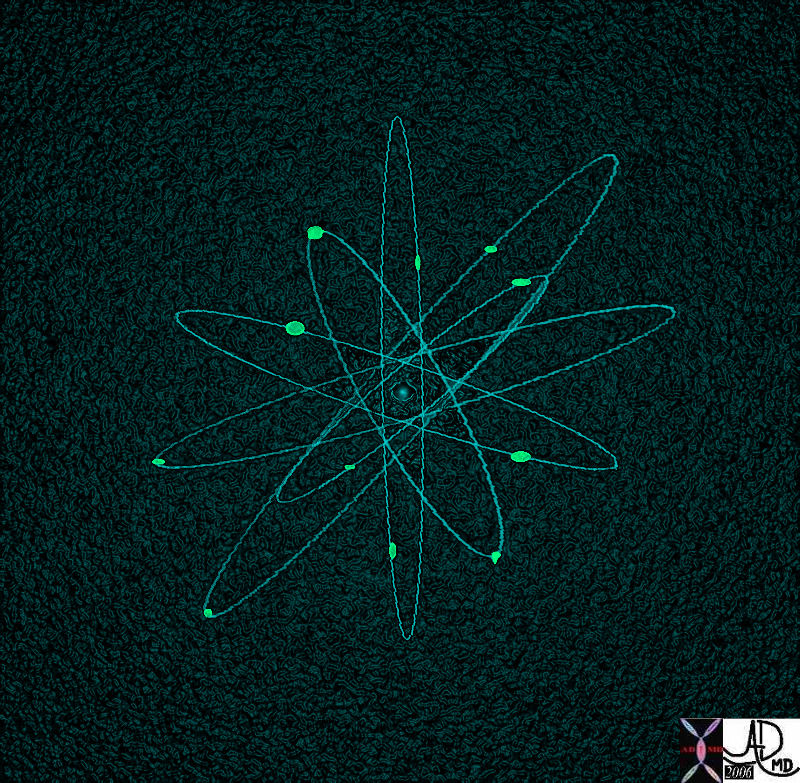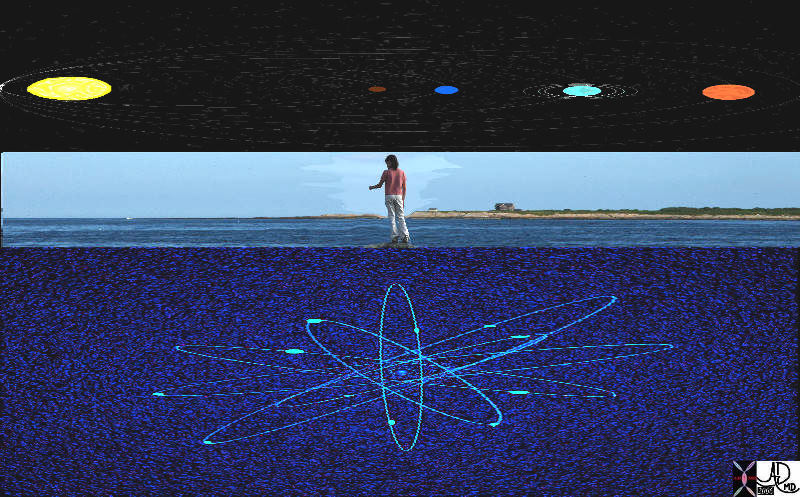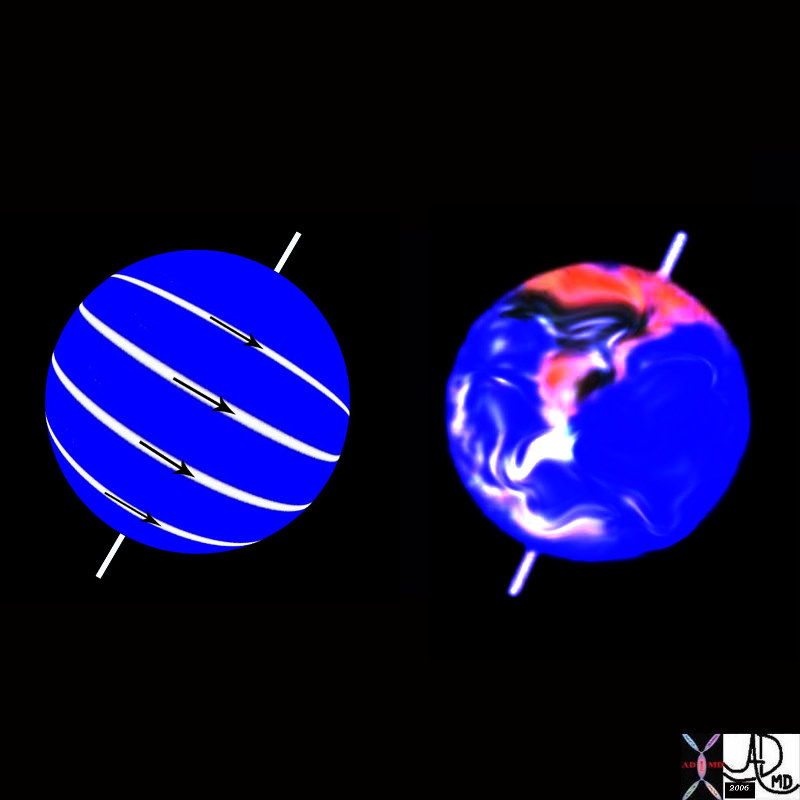Ashley Davidoff MD 2011
The cell, as the building block of biology is made of smaller parts. Hooke was barely skimming the surface when he discovered the cell. Little did he know that thousand of years before him in approximately 450 BCE, Democritus coined the term átomos which means “uncuttable” or “the smallest indivisible particle of matter”.
On the other end of the spectrum the concept of the universe has been evolving starting with the ancient Greeks evolving with Copernicus’s heliocentric model and the Newtonian model of the solar system.
As we have become to understand and theorise the structure of the atom and the universe and observe the structure of the solar suystem, we realise that the conceptual frameworks of the artom and the universe have similarities.
Take a moment to look and think about the model of the atom on the one end of the spectrum, and the model of the solar system on the other. One can only marvel in wonder at the similarity of their structure. In essence a central body is surrounded by other orbiting bodies and are kept together by bounding and bonding forces.
The sight of the stars on a clear, dark night can be breathtaking. From a distance of over four or five light years they seem more like an endless quilt of twinkling lights than the volatile, gaseous orbs that they are. Indeed, they constitute but one part of an enigmatic and seemingly unknowable universe that has captivated mankind for centuries, leading to countless attempts to unravel the mystery enshrouding it. Whether through science and mathematics or elaborate mythologies, man has attempted to understand the planets and galaxies that lie beyond his grasp. However, even today, after years of such research, these planets and galaxies seem vastly and almost incomprehensibly different from ours – so much so that the common man can only venture a guess as to what truly lies beyond our solar system. Yet, if one takes a moment to compare our world with the celestial ones beyond our gaze striking similarities become apparent and just as we marvel at the wonders of the universe so may we stand in awe of our own planet Earth.
One of the first things one learns in elementary science is the structure of the solar system, the organization of eight planets revolving in mathematically predictable paths about a giant sun. We also learn that each of these planets, in turn, is orbited by one or several moons. In the study of chemistry the atom, a fundamental unit of chemical structure, is explained as a nuclear core surrounded by constantly and rapidly moving electrons. In just these brief explanations the structural theme common to the atom, the solar system, and its planets becomes clear, illustrating just one of the remarkable conceptual links that can relate earth science to the universe.

The Atom – Powerful and “Indivisible” |
| 45824b15.800b01 Davidoff art |
Indeed, this observation inspires us to determine how biology may be related to the larger schemes of the universe, and, ultimately, how human beings figure into the big picture.
|
Where does biology fit in between the atom and the solar system and universe? |
|
The atom, the building block of all structure, is seen at the bottom while the solar system, its analog in structure , has been positioned at the top of the image. Between the two stands my daughter, Danielle, on the beaches of Newport, Rhode Island, pondering at the age of nine years where she and the rest of biology fit into the grand scheme of things. (Image courtesy of Ashley Davidoff M.D.) 45826b04.800 |
Units to Unity – The Atom to Molecule and then Onward
The path from the atomic end of the spectrum to biology is within our grasp of understanding as we see atoms and elements build molecules which become more complex as they build to macromolecules and subsequently build biologic elements of protein carbohydrates and fat. With exquisite organization biology is born as these building blocks combine to form cellular components such as nucleic acids, membranes, endoplasmic reticula and golgi apparatuses. Therafter the nuts and bolts of life get born so that the cells, tissues, organs and body systems are within our comprehension and our sciences. The secret of how the thinking feeling and spiritual being comes about, is the beginning of an abstract quest of life. Beyond to the universe is up only for speculation and not within the expertise of this book.. The idea of units to unity, of how elements combine to form a newer and larger unit bigger and more powerful than the individual parts remains an elemental concept at the biological level. One suspects that beyond our earth, this same concept has some role in the way the structures unfold..
Where does biology fit in between the atom and the solar system and universe?
In analyzing the makeup of the human body as compared to that of the earth one comes across a variety of striking similarities that lend themselves to the idea that there is symmetry amidst the chaos of the universe. For example, both the earth and the human body are composed of approximately 60-70% water, and even slight variation in these levels can lead to disaster – flooding or physiologic malfunction, respectively. The atomic composition of the body and the earth are also quite comparable. If one were to sum all the atoms present in the body the hydrogen atom would be most abundant, as it comprises nearly 2/3 of the body’s atoms. Furthermore, each hydrogen atom is characterized by a magnetic field in its center, which directs the spin, or precession, of the atom about a slanted axis. Remarkably, the same description may be aptly used in describing the earth’s structure, magnetic field, and axial rotation, highlighting another coincidence in the physical properties of the body and our planet. In this way, we see structural themes embodied and recapitulated in miniscule atomic particles, large planetary masses, and everything in between.
|
The Hydrogen Atom and the Earth |
|
13451c06.800 TCV hydrogen atom earth TCV Davidoff Oneness Davidoff art Concepts |
Within the Common Vein I seek to methodically construct understanding of the body and medicine. The purpose of this introduction to matters of the universe is to provide a structural and perhaps philosophical context . In this chapter I have done my best to portray this and to point out to the reader that beyond medicine, our bodies, science, and this earth lies a vast expanse of yet un-navigated wilderness. We get a sense of this frontier every time we gaze at the stars and the black nothingness that serves as their backdrop. This sense of awe and appreciation for a greater cosmos, I believe, is intrinsic to the human experience, as so much of it is consumed by attempts to find one’s place within the universe. We are more than cells and organized arrangements of atoms, and as such seek answers to difficult and intimate questions whose answers are not found in this or any other textbook. Indeed, sometimes it is only by positioning ourselves before the enormity of the universe, somewhere between the ground and the stars, that we may know our place in the grand scheme of creation.


